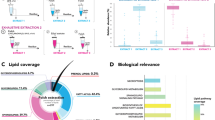Abstract
Purpose
The stability of NBOMes, potent new psychoactive substances, in whole blood was studied over 180 days.
Method
We present a fully validated liquid chromatography–tandem mass spectrometry method to quantify seven NBOMes (25B-, 25C-, 25D-, 25E-, 25G-, 25H- and 25I-NBOMe) in whole blood, and a 180 day stability at two analyte concentrations and three storage temperatures [room temperature (RT), 4 °C and −20 °C].
Results
Calibration curves were linear over 0.1–10 ng/mL, with intra- and interday imprecision (% relative standard deviation) and bias (%) not greater than 8.1 %. For low concentration (0.3 ng/mL) samples at RT, 25B-, 25C-, 25I- and 25E-NBOMe decreased by more than 20% after 15 days and were undetectable after 30 days. All NBOMes were below the limit of quantification (LOQ; 0.1 ng/mL) when stored at RT for 60 days. At 4 °C, 25B-, 25C-, 25I-, 25G-, 25D- and 25E-NBOMe (0.3 ng/mL) decreased by more than 20% (up to 54%) after 180 days. Except for 25H-NBOMe, all high concentration (8 ng/mL) NBOMes decreased by more than 20% after 15 days at RT, and high concentrations of 25B-, 25C-, and 25I-NBOMe were unstable at 4 °C after 180 days. All analytes were stable for 180 days at −20 °C. Extracts of low, medium and high quality control samples were stable when reinjected after 32 h storage on the autosampler at 15 °C. All analytes were stable after three freeze-thaw cycles at −20 °C.
Conclusions
Based on the potential for NBOMe instability prior to testing, it is recommended to refrigerate whole blood for NBOMe analysis up to 90 days, and to freeze samples for longer term storage.






Similar content being viewed by others
References
Suzuki J, Dekker MA, Valenti ES, Arbelo Cruz FA, Correa AM, Poklis JL, Poklis A (2015) Toxicities associated with NBOMe ingestion—a novel class of potent hallucinogens: a review of the literature. Psychosomatics 56:129–139. https://doi.org/10.1016/j.psym.2014.11.002
Poklis JL, Nanco CR, Troendle MM, Wolf CE, Poklis A (2014) Determination of 4-bromo-2,5-dimethoxy-N-[(2-methoxyphenyl)methyl]-benzeneethanamine (25B-NBOMe) in serum and urine by high performance liquid chromatography with tandem mass spectrometry in a case of severe intoxication. Drug Test Anal 6:764–769. https://doi.org/10.1002/dta.1522
Rose SR, Poklis JL, Poklis A (2013) A case of 25I-NBOMe (25-I) intoxication: a new potent 5-HT2A agonist designer drug. Clin Toxicol 51:174–177. https://doi.org/10.3109/15563650.2013.772191
Poklis JL, Charles J, Wolf CE, Poklis A (2013) High-performance liquid chromatography tandem mass spectrometry method for the determination of 2CC-NBOMe and 25I-NBOMe in human serum. Biomed Chromatogr 27:1794–1800. https://doi.org/10.1002/bmc.2999
Suzuki J, Poklis JL, Poklis A (2014) “My friend said it was good LSD”: a suicide attempt following analytically confirmed 25I-NBOMe ingestion. J Psychoactive Drugs 46:379–382. https://doi.org/10.1080/02791072.2014.960111
Hermanns-Clausen M, Angerer V, Kithinji J, Grumann C, Auwärter V (2017) Bad trip due to 25I-NBOMe: a case report from the EU project SPICE II plus. Clin Toxicol 55:922–924. https://doi.org/10.1080/15563650.2017.1319572
Morini L, Bernini M, Vezzoli S, Restori M, Moretti M, Crenna S, Papa P, Locatelli C, Osculati AMM, Vignali C, Groppi A (2017) Death after 25C-NBOMe and 25H-NBOMe consumption. Forensic Sci Int 279:e1–e6. https://doi.org/10.1016/j.forsciint.2017.08.028
Ameline A, Kintz P, Blettner C, Bayle É, Raul J-S (2017) Identification of 25I-NBOMe in two intoxications cases with severe hallucinations. Toxicol Anal Clin 29:117–122. https://doi.org/10.1016/J.TOXAC.2016.11.004
Hill SL, Doris T, Gurung S, Katebe S, Lomas A, Dunn M, Blain P, Thomas SH (2013) Severe clinical toxicity associated with analytically confirmed recreational use of 25I-NBOMe: case series. Clin Toxicol 51:487–492. https://doi.org/10.3109/15563650.2013.802795
Shintani-Ishida K, Saka K, Nakamura M, Yoshida KI, Ikegaya H (2018) Experimental study on the postmortem redistribution of the substituted phenethylamine, 25B-NBOMe. J Forensic Sci 63:588–591. https://doi.org/10.1111/1556-4029.13583
Wiergowski M, Aszyk J, Kaliszan M, Wilczewska K, Anand JS, Kot-Wasik A, Jankowski Z (2017) Identification of novel psychoactive substances 25B-NBOMe and 4-CMC in biological material using HPLC-Q-TOF-MS and their quantification in blood using UPLC–MS/MS in case of severe intoxications. J Chromatogr B 1041-1042:1–10. https://doi.org/10.1016/j.jchromb.2016.12.018
Al-Imam A (2018) 25b-NBOMe: a case report of sudden death and insightful view of Google trends data. Iran J Psychiatry Behav Sci 12:e9870. https://doi.org/10.5812/ijpbs.9870
Soh YNA, Elliott S (2014) An investigation of the stability of emerging new psychoactive substances. Drug Test Anal 6:696–704. https://doi.org/10.1002/dta.1576
Johnson RD, Botch-Jones SR, Flowers T, Lewis CA (2014) An evaluation of 25B-, 25C-, 25D-, 25H-, 25I- and 25T2-NBOMe via LC-MS-MS: method validation and analyte stability. J Anal Toxicol 38:479–484. https://doi.org/10.1093/jat/bku085
Scientific Working Group for Forensic Toxicology (SWGTOX) (2013) Standard practices for method validation in forensic toxicology report from the Scientific Working Group for Forensic Toxicology. J Anal Toxicol 37:452–474. https://doi.org/10.1093/jat/bkt054
da Cunha KF, Eberlin MN, Costa JL (2018) Development and validation of a sensitive LC–MS/MS method to analyze NBOMes in dried blood spots: evaluation of long-term stability. Forensic Toxicol 36:113–121. https://doi.org/10.1007/s11419-017-0391-8
Acknowledgements
The authors thank Fundação de Amparo à Pesquisa do Estado de São Paulo–FAPESP (Process Number 2015/10650-8 and 2018/00432-1), Conselho Nacional de Desenvolvimento Científico e Tecnológico–CNPq (Process Number 131780/2017-4), and Superintendência da Polícia Técnico-Científica for kind donation of authentic samples.
Author information
Authors and Affiliations
Corresponding author
Ethics declarations
Conflict of interest
There are no financial or other relations that could lead to a conflict of interest.
Ethical approval
All procedures performed in studies involving human participants were in accordance with the ethical standards of the University of Campinas committee (Comitê de Ética em Pesquisa da UNICAMP—CEP, CAAE 8452716.2.0000.5404 and Superintendência da Polícia Técnico-Científca, ofício No. 766/2015/ATS/SPTC-SSP).
Electronic supplementary material
Below is the link to the electronic supplementary material.
Rights and permissions
About this article
Cite this article
da Cunha, K.F., Eberlin, M.N., Huestis, M.A. et al. NBOMe instability in whole blood. Forensic Toxicol 37, 82–89 (2019). https://doi.org/10.1007/s11419-018-0438-5
Received:
Accepted:
Published:
Issue Date:
DOI: https://doi.org/10.1007/s11419-018-0438-5




